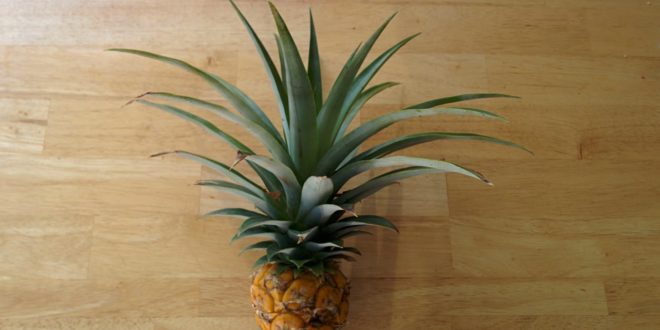In March 2016, on a whim, I bought a pineapple plant for my Sunnyvale garden. I know. I transplanted it to a larger pot but made the mistake of a too shallow pot. It grew a little and eventually in July we harvested our pineapple. If I was thinking of serving drinks in it, I would only need a shot glass.
 I transplanted the plant into a wider and deeper pot. Here it is in November 2016 and our plant has two baby plants emerging from the sides.
I transplanted the plant into a wider and deeper pot. Here it is in November 2016 and our plant has two baby plants emerging from the sides.
Next year, I am ready with the umbrellas.
The pineapple (Ananas comosus) is a tropical plant with edible multiple fruit consisting of coalesced berries. Pineapples may be cultivated from a crown cutting of the fruit, possibly flowering in 20–24 months and fruiting in the following six months.
For math geeks: The fruit of a pineapple is arranged in two interlocking helices, eight in one direction, 13 in the other, each being a Fibonacci number. It is unknown whether we first discovered this pattern in mathematics and then discovered this pattern in nature OR if we discovered the pattern in nature and then abstracted the pattern in mathematics.
The pineapple carries out CAM photosynthesis. CAM (Crassulean Acid Metabolism) photosynthesis is a strategy used by plants in arid environments (like cactus and other succulents) to reduce water loss. In a plant using full CAM, the stomata in the leaves remain shut during the day to reduce evapotranspiration, but open at night to collecting and fixing carbon dioxide at night and storing it as the acid malate, then releasing it during the day aiding photosynthesis.
Pineapples can be consumed fresh, cooked, juiced, or preserved.
In the scientific binomial Ananas comosus, ananas, the original name of the fruit, comes from the Tupi word nanas, meaning “excellent fruit”, as recorded by André Thevet in 1555, and comosus, “tufted”, refers to the stem of the fruit. The pineapple is a herbaceous perennial, which grows to 3.3 to 4.9 ft tall, although sometimes it can be taller. In appearance, the plant has a short, stocky stem with tough, waxy leaves. When creating its fruit, it usually produces up to 200 flowers, although some large-fruited cultivars can exceed this. Once it flowers, the individual fruits of the flowers join together to create what is commonly referred to as a pineapple. After the first fruit is produced, side shoots (called ‘suckers’ by commercial growers) are produced in the leaf axils of the main stem. These may be removed for propagation, or left to produce additional fruits on the original plant.








